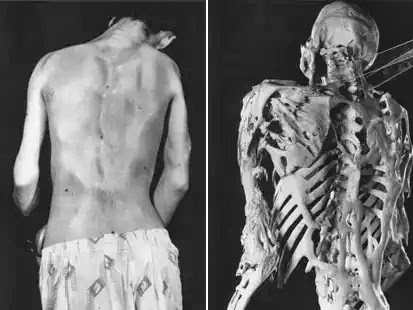They suffer from oversensitivity to sunlight.
Garlic gives them severe abdominal pains.
Their gums recede giving them the appearance of fangs.
Porphyria occurs when there is a build-up of chemicals called porphyrins in the body as a result of disruption in the production of heme, which is an iron-rich component of the haemoglobin.
Porphyria cannot really be cured but can be managed by the regular supply of blood. But unlike vampires, they don't drink the blood but it gets into their body through transfusion.
2.
Congenital Hypertrichosis: This is a very rare and peculiar syndrome, it is also called the "Human Werewolf Syndrome". It causes excess hair to grow on the body and those who suffer from it also experience Gingival Hyperplasia (tooth defects) which gives them the appearance of werewolves.Only about 50 people in the world are known to have suffered from this syndrome.
3.
Epidermodysplasia Verruciformis: It is also called the "Tree Bark Skin Disorder" and is a very rare disorder characterised by eruptions of wart-like lessions that may pop-up anywhere in the body.This is a subtype of the Human Pappiloma Virus (HPV) and there is no known cure yet.
4. Hutchinson-Gilford Progeria Syndrome: This particular syndrome makes children to look very old and elderly before they are even two years old. And this happens without any change in intellectual development or motor skill development.
They simply become elderly infants. Symptoms are as follows:
Prominent eyes, thin nose with beaked tip, protruding eyes, small chin and thin lips.
They also suffer from hair loss, aging skin, joint abnormalities e.g arthritis and enlarged skull.
Children who suffer from this syndrome usually don't live beyond their teenage years.
5.
Persistent Sexual Arousal Syndrome: This is a very rare neurological (and maybe hormonal) condition. They suffer from persistent sexual and genital arousal and they find themselves on the verge of orgasm almost 24 hours everyday.It is so distressful, embarassing and unnatural that people who suffer from it often turn to suicide for relief.
Scientists are still confused as to what might be the real cause of this embarassing condition.
6. Fibrodysplasia Ossificans Progressive (FOP): It is also known as the "Living Statue Syndrome". It is one of the most painful and disabling conditions you can find.
It occurs when bones are formed in muscles, tendons, ligaments and other connecting tissues and these bones then develop across joints forming a second skeleton which also severely restricts even the simplest bodily movements. The person looks like a living statue.
It has no known effective treatment and injuries or surgeries sometimes makes it worse.
7.
Alien Hand Syndrome: This is a rare condition in which one of the limbs (arms or legs) acts independently without the concious control of that person.
The left hand could suddenly slap a person or start unbuttoning the shirts or pants in public. The person has full sensation in the rogue hand or leg but is not in control of it's movement.
8.
Congenital Insensitivity to Pain: This rare condition makes people to become totally insensitive to physical pain and they cannot feel anything when injured or when their tongues are touched by very hot food.
It is believed to be as a result of a mutation in the gene that controls pain-sensing neurons.
9.
Eosinophilic Esophagitis is a very rare and very serious allergic/immune condition which causes an allergy to foods, not just particular kinds of foods but all foods. In some extreme cases even the scent of food is enough to cause hospitalisation.
It occurs with the inflamation of the aesophagus and certain white blood cells called "eosinophils"(not normally found in the oesophagus) appears.
10. Micropsia: It is also called "Alice in Wonderland Syndrome" and it affects the human visual perception such that objects are perceived as substantially smaller than they really are.
In some cases the objects might appear both far away and extremely close at the same time. A dog may appear the size of a mouse, a house may appear the size of a small car.
Interestingly the eyes are not in any way impaired, the problem comes from the brain and how it interpretes information that comes from the eyes.
















